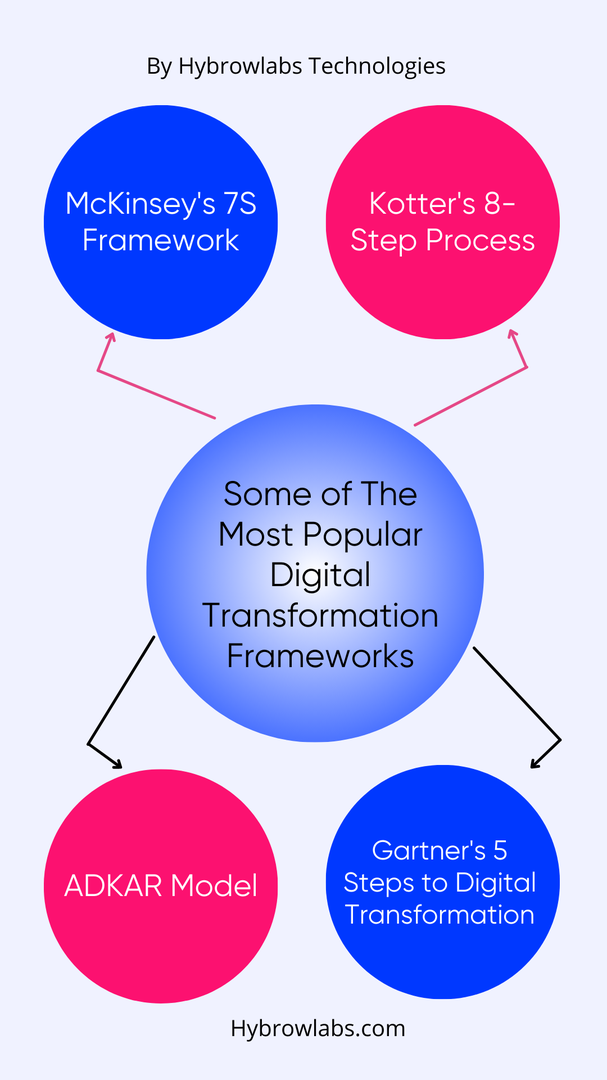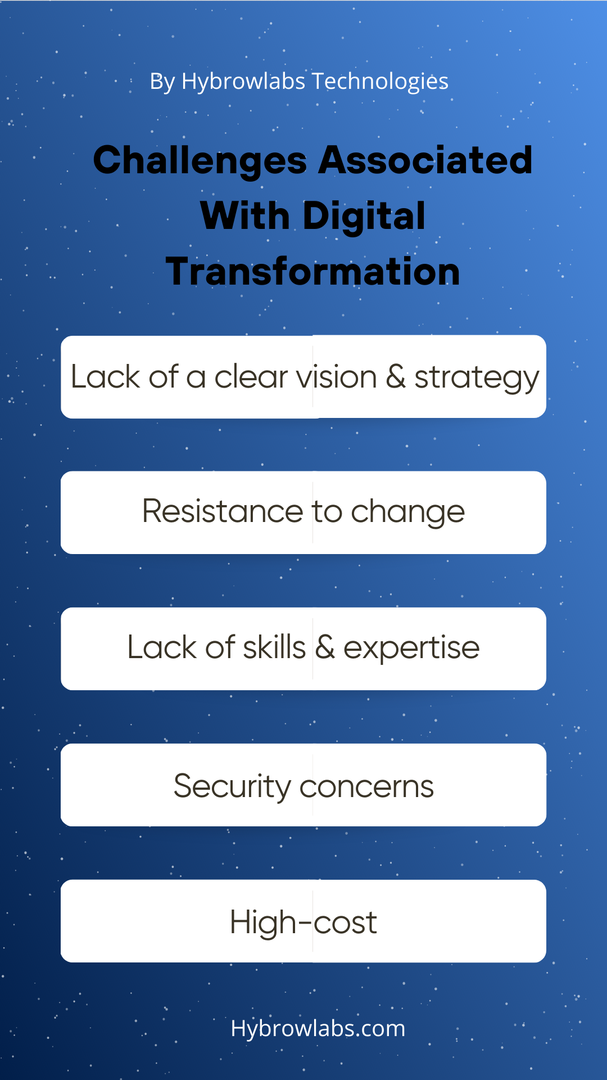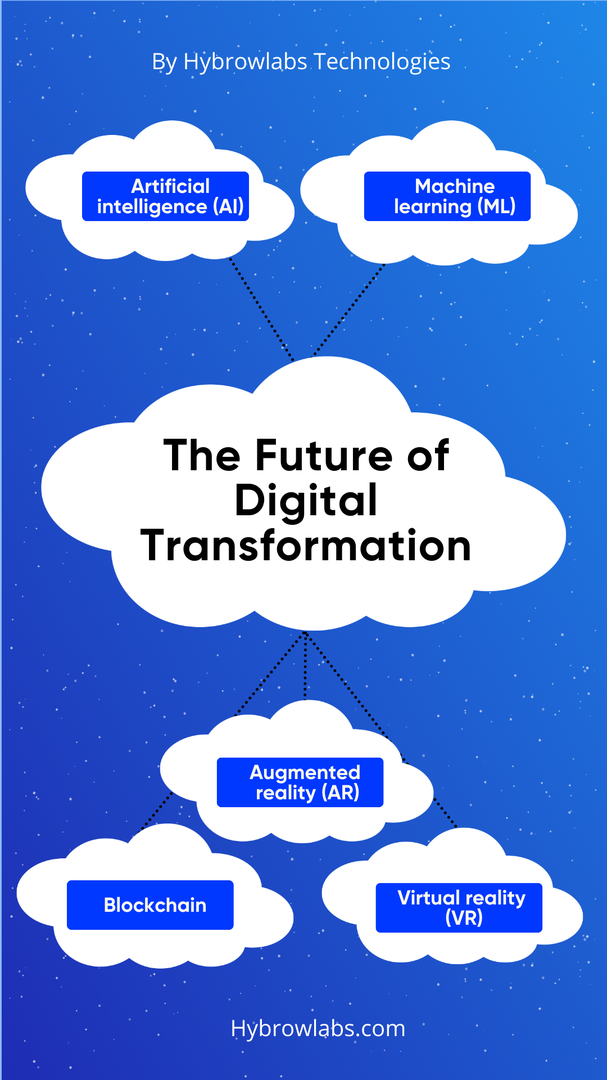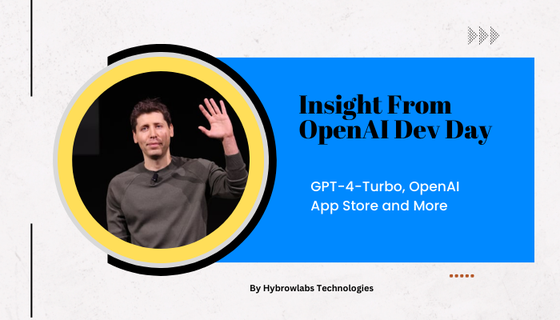In today's lightning-paced digital landscape, staying ahead of the curve isn't a choice; it's a necessity. Welcome to the exciting realm of digital transformation, where businesses are not just adapting but thriving in the digital age.
Imagine your business as a ship navigating uncharted waters. Digital transformation is the compass that not only guides your ship but helps it set sail toward new horizons. It's more than just a buzzword; it's the key to reshaping the very core of how businesses operate, deliver value to customers & ensure long-term success. Today in this blog we will discover the challenges associated with digital transformation, Common Digital Transformation Frameworks, common mistakes organizations make during digital transformation & more. So let’s go on a voyage with the ship to understand more about digital transformation and its framework.
More read- Crafting Effective Digital Transformation Teams: Optimal Project Structures
Understanding Digital Transformation
To truly get the significance of digital transformation and digital transformation teams, let's take a step back and revisit our previous blog, Crafting Effective Digital Transformation Teams: Optimal Project Structures. In that exploration, we unveiled What is Digital Transformation, how digital transformation can solve modern business problems, what is digital transformation team, what are its key elements & core team members, etc.
Now, armed with that foundational knowledge, we're ready to dive deeper into the practical frameworks that can turn this concept into a reality for your organization. Let's move from theory to action as we explore the tools & strategies to chart your course toward digital transformation success.
Why do Businesses Need Structured Frameworks For Digital Transformation?

1. To provide a roadmap:
A structured framework can help businesses clarify their goals, determine the steps they require to take, & track their progress. This can be especially helpful for large organizations that are undergoing digital transformation.
2. To mitigate risk:
Digital transformation is a difficult & disruptive process, so there is always the risk of failure. By using a structured framework businesses can identify and mitigate risks & increase their chances of success.
3. To ensure alignment:
Digital transformation requires a cross-functional effort & it's important to ensure that everyone is aligned on the goals & objectives. A structured framework can help to promote alignment & collaboration across the organization.
4. To build momentum:
Digital transformation can be a time-consuming & challenging journey & it's important to build momentum. Only a structured framework can help businesses to stay focused & motivated.
Introducing The Most Popular Digital Transformation Frameworks:

There are many different digital transformation frameworks available, each with its own strengths & weaknesses. The best framework for a particular organization will depend on its specific circumstances & goals. In this section, we will introduce some popular digital transformation frameworks: McKinsey's 7S Framework, ADKAR Model, Kotter's 8-Step Process, Capgemini's Digital Transformation Framework & Gartner's 5 Steps to Digital Transformation.
1. McKinsey's 7S Framework:
This framework identifies seven interconnected factors that are important for successful digital transformation: strategy, structure, systems, style, staff, skills & shared values.
2. ADKAR Model:
This framework focuses on the five key dimensions of change: awareness, desire, knowledge, ability & reinforcement
3. Kotter's 8-Step Process:
This framework outlines eight steps for leading organizational change: 1) create a sense of urgency, 2) form a powerful guiding coalition, 3) create a vision and strategy, 4) communicate the vision, 5) empower others to act on the vision, 6) gain short-term wins, 7) consolidate gains and produce more change, 8) institutionalize the changes.
4. Capgemini's Digital Transformation Framework:
This framework focuses on four key areas for digital transformation: customer experience, operational excellence, business model innovation & new growth.
5. Gartner's 5 Steps to Digital Transformation:
This framework outlines five key steps for digital transformation: establish a vision, build a foundation, accelerate adoption, scale for impact & sustain momentum.
Tailoring Digital Transformation: Steps to Customize Your Framework
Digital transformation frameworks offer valuable blueprints for change, but one size does not fit all. To maximize their effectiveness, it's crucial to customize these frameworks to align with your organization's unique needs & aspirations. Here are the essential steps involved in this vital process:
1. Assess Your Current State:
- Begin by executing a thorough assessment of your organization's current state. Identify what are your strengths and weaknesses! What digital capabilities do you already possess & where are the gaps?
- Understand your organization's culture, as it plays a significant role in shaping how you approach & implement change.
For example- TechEdge Inc. is a mid-sized technology company facing increasing competition in their market. They begin by assessing their current state, realizing that their traditional product development processes are slowing them down & customer satisfaction is declining.
2. Define Your Goals and Objectives:
- Clearly articulate what you aim to achieve through digital transformation. Your goals should be specific, measurable, achievable, relevant & time-bound (SMART).
- Align your goals with your overall business strategy and vision.
For example- TechEdge Inc. defines its objectives: improve product development speed, enhance customer experiences & remain competitive in the rapidly evolving tech industry. Their goal is to become more agile & innovative.
3. Select an Appropriate Framework:
- Choose a digital transformation framework that best suits your organization's goals, industry & culture. Consider frameworks such as McKinsey's 7S, ADKAR, or Kotter's 8-Step Process.
- Ensure that the framework aligns with your objectives & can address your organization's specific challenges.
For example- After thorough research, they opted for the Agile Transformation Framework due to its emphasis on flexibility & innovation, aligning with their goals.
4. Customize Framework Components:
- Tailor each component of the chosen framework to fit your organization's needs. This may involve modifying processes, structures, technologies, or people-related aspects.
- Ensure that the customized framework aligns seamlessly with your existing operations.
For example- TechEdge Inc. reviews the Agile Transformation Framework's components & tailors them to their needs. They emphasize customer-centricity, quicker release cycles & cross-functional teams.
5. Engage Stakeholders:
- Involve key stakeholders from all levels of your organization in the customization process. Their insights & buy-in are critical for success.
- Create cross-functional teams to work on different aspects of the framework customization.
For example- They involve key stakeholders, including product managers, developers & customer support, in workshops & discussions to gather insights & buy-in.
6. Develop a Roadmap:
- Create a detailed roadmap that outlines the steps, milestones & timelines for implementing the customized framework.
- Prioritize initiatives based on their impact & feasibility.
For example- TechEdge Inc. creates a detailed roadmap outlining the transition to Agile. It includes specific milestones, such as adopting Scrum & Kanban methodologies.
7. Build a Change Management Plan:
- Develop a robust change management plan that addresses communication, training & employee engagement.
- Anticipate resistance to change & prepare strategies to overcome it.
- They allocate funds for training on Agile methodologies & hire Agile coaches to guide teams through the change. To manage resistance, they develop a change management plan that involves regular communication, addressing concerns & providing forums for employee feedback.
8. Test and Refine:
- Pilot the customized framework in a controlled environment before scaling it across the entire organization.
- Collect feedback & data to identify areas for improvement & refinement.
-TechEdge Inc. begins with a pilot project in one product division. They implement Agile practices, like daily stand-up meetings & sprint planning.
9. Monitor and Measure:
- Establish key performance indicators (KPIs) to track the progress & impact of your digital transformation efforts.
- Continuously monitor & measure these KPIs to ensure that you are moving toward your goals.
- Regularly reviewing project progress, they make adjustments. They find that the teams need more training on Agile tools, which they provide.
10. Repeat and Adapt:
- Digital transformation is an ongoing process. Regularly assess your framework's effectiveness & be willing to make adjustments as needed.
- Stay attuned to industry trends & emerging technologies to ensure your framework remains relevant.
- After the initial transformation, TechEdge Inc. evaluates its progress. They see significant improvements in product delivery & customer satisfaction. They use this insight to fine-tune their Agile framework further.
11. Celebrate Successes:
- Acknowledge & celebrate achievements along the way. Recognize the efforts of your teams & the positive changes brought about by the customized framework.
- Seeing success in the pilot division, they gradually expand Agile practices across all divisions, ensuring alignment with each division's unique needs. Continuous training & feedback mechanisms become part of their culture, sustaining their digital transformation.
Challenges Associated With Digital Transformation And How To Avoid These?

Here are some specific challenges that organizations often face when undergoing digital transformation, in more descriptive terms:
1. Lack of a clear vision and strategy:
It's essential to have a clear vision of what you want to achieve in your business with digital transformation & to prepare a strategy for reaching there. The strategies include understanding the organization's current status, anticipated future state & the activities required to bridge the gap.
2. Resistance to change:
Many people don’t like change but digital transformation will bring a lot of changes to the business to grow it continuously. It has the potential to transform how people work, interact with consumers & conduct business. It is necessary to communicate the benefits of digital transformation to employees & consumers & make sure that everyone is on board with the changes.
3. Lack of skills and expertise:
Digital transformation needs the development of new skills & expertise, which many organizations don’t have. Data analytics, cloud computing & user experience design are examples of such skills. It is essential to invest in training & development, as well as to hire outside experts if needed.
4. Security concerns:
As digital transformation involves accumulating & storing large amounts of data, it can put organizations at new security risks. It's important to have a strong security plan in place to protect sensitive data.
5. Cost:
Digital transformation can be costly because it involves funding new technologies, training employees & making changes to the way the organization works. It's crucial to carefully evaluate the costs & benefits of each project before moving forward.
The Future of Digital Transformation:

Here are some emerging technologies and trends that will shape the future of digital transformation:
1. Artificial intelligence (AI):
AI is rapidly evolving & becoming more sophisticated. It is already being used in a variety of ways for customer service, fraud detection & product recommendations. In the future, AI is likely to play an even greater role in digital transformation, helping organizations to automate tasks, make better decisions & improve customer experiences.
2. Machine learning (ML):
ML is a subset of AI that allows computers to learn without being explicitly programmed. ML is already being used in various ways like spam filtering, image recognition & fraud detection. In the future, ML is likely to play an even greater role in digital transformation, helping organizations to make better decisions & improve their products & services.
3. Blockchain:
Blockchain is a distributed ledger technology that allows for secure, transparent & tamper-proof transactions. Blockchain is still in its early stages of development, but it has the potential to revolutionize a variety of industries like finance, supply chain management & healthcare.
4. Virtual reality (VR):
VR is a technology that creates a simulated environment that users can interact with. VR is already being used for gaming, training & entertainment. In the future, VR is likely to play an even greater role in digital transformation, helping organizations to provide immersive customer experiences & training.
5. Augmented reality (AR):
AR is a technology that overlays digital information into the real world. AR is already being used for gaming, navigation & shopping. In the future, AR is likely to play an even greater role in digital transformation, helping organizations to provide contextual information & improve productivity.
In addition to the emerging technologies & trends mentioned above, it is also important for organizations to focus on ongoing adaptation & innovation. The digital landscape is constantly changing, organizations it is important to be able to adapt their business models & processes accordingly. This can be done by investing in research and development, by creating a culture of innovation & by being open to new ideas.
Conclusion:
Digital transformation is a complicated & disruptive process that can be dangerous for firms that lack a clear plan or framework. Without a framework, firms may lose focus, raise their chance of failure, endure employee & customer unhappiness, face more significant security concerns & incur expense overruns. Businesses should acquire buy-in from all stakeholders, start small & build-up, be agile & adaptable & monitor success to reduce these risks. Businesses can boost their chances of success with digital transformation by following these guidelines.
Do you want to use digital technology to transform your business? Hybrowlabs can assist. We can help you set your goals, manage risks & maintain alignment across your organization using our proven methodology & experience. We can also assist you in implementing & managing your digital transformation projects by providing training & development, consulting services & managed services. We have the knowledge, expertise & resources to assist you in reaching your objectives. To learn more, please contact us immediately.
If you want to know more about project Management vs. Organizational Change Management here is a guide for you- Project Management vs. Organizational Change Management.
1. What is digital transformation?
Digital transformation is the process of leveraging digital technologies to fundamentally change how businesses operate, deliver value to customers & stay competitive in the digital age.
2. How do I choose the right digital transformation framework for my organization?
Select a framework that aligns with your organization's goals, culture & industry. Consider factors like scalability, flexibility & the specific challenges you aim to address.
3. How do I involve employees in the digital transformation process?
Engage employees by communicating the benefits of the transformation, providing training & support, creating cross-functional teams & encouraging innovation & collaboration.
4. How can I measure the success of my digital transformation efforts?
Success can be measured through key performance indicators (KPIs) like increased revenue, improved customer satisfaction, reduced costs, faster time-to-market & enhanced employee productivity.
5. How long does a typical digital transformation process take?
The duration of a digital transformation varies depending on the complexity of the organization, its goals & the chosen framework. It can range from several months to several years.



.png)


a3dc85.jpg)

.jpg)
fd8f11.png)

.jpg)
.jpg)